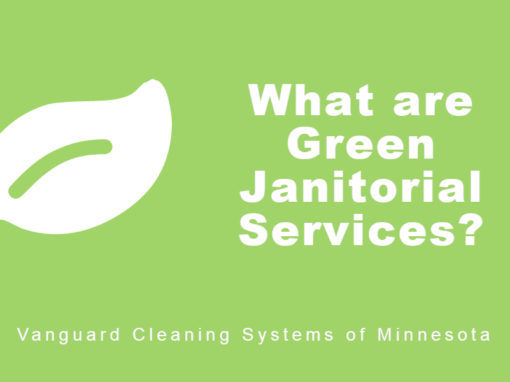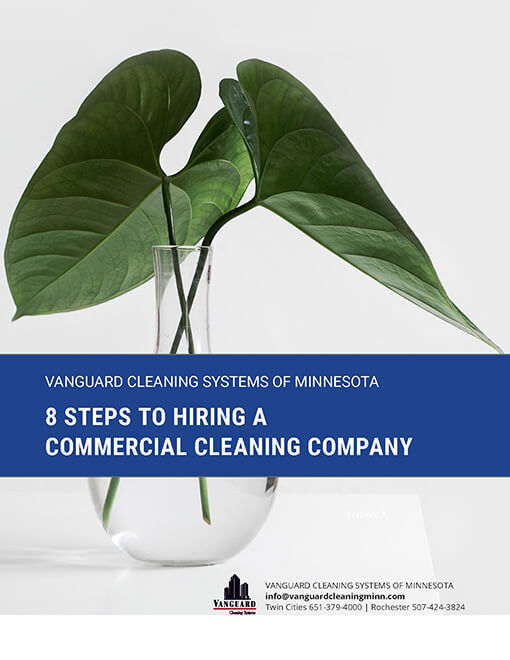Vanguard Cleaning Systems

Green Janitorial Services
Green janitorial services and product purchasing significantly reduce or eliminate the level of toxins we are exposed to, or are released into the local environment.
As the needs of business and education continue to evolve towards a socially and ecologically responsible model, green janitorial services, products, and technologies have emerged to accept the challenge of cleaning up our planet, and leave it better than we found it.
Originally defined in 1998 by Executive Order 13101 as a policy;
[sic]…for the acquisition and use of environmentally preferable products and services and implement cost-effective procurement preference programs favoring the purchase of these products and services.
Executive Order 13101—Greening the Government Through Waste Prevention, Recycling, and Federal Acquisition
The definition was later updated in 2007 by EO 13423, which added an emphasis to sustainable practices, ordering;
[sic]…Federal agencies to conduct their environmental, transportation, and energy-related activities under the law in support of their respective missions in an environmentally, economically and fiscally sound, integrated, continuously improving, efficient, and sustainable manner.
EO 13423 (Archive) – revoked by EO 13693 on March 19, 2015, Sec. 16(a)
The final ruling, EO 13693, which took effect in 2016, further emphasized sustainable practices, product life-cycle management, energy and resource conservation, as well as waste management, ordering;
[sic]…where life-cycle cost-effective, beginning in fiscal year 2016, unless otherwise specified, promote building energy conservation, efficiency, and management by reducing agency building energy intensity…[sic].
In This Article
Environmentally Friendly Product Purchasing
Environmentally preferred products are defined by the U.S. General Services Administration as;
[sic]…[Products] and services [which] have a lesser or reduced negative effect on human health and the environment when compared with competing products or services that serve the same purpose.
Environmentally Preferred Products
Unfortunately, current Federal Guidelines fail to regulate consumer product labeling, allowing for the misrepresentation of cleaning product and chemical labels, as well as allowing manufacturers to dance around the definition of ‘Green,’ and ‘Environmentally Sound.’
This practice has led to the inclusion of several toxic chemicals, which do not meet established guidelines, in consumer cleaning products.
The safest way to avoid this trap is to centralize product purchasing through a certified green janitorial vendor with an established history and reputation for honesty and transparency.
The best place to start is to have your facilities maintenance or property management team sit down and review the labels of chemicals used in all building practices, identify products that do not meet established guidelines, and eliminate their use in favor of goods that have been scientifically tested as safer for use in enclosed spaces, as well as for the environment.
See Also:
Sustainable Business Practices
The concept and definition of sustainability is typically attributed to the U.N. Brundtland Commission, which concluded;
Sustainable development is development that meets the needs of the present without compromising the ability of future generations to meet their own needs.
Report of the World Commission on Environment and Development: Our Common Future
Sustainability laid the groundwork for future pillars of green cleaning and living, which we will discuss later, but specifically, focuses on a holistic approach to how, and from whom, resources are acquired, managed, and disposed of.
- Products must be purchased from a vendor which aligns their practices with recognized sustainability guidelines.
- Products must be used in a way that does not hamper access to resources for future generations, and;
- Products must be disposed of in a way that does not damage the environment or possess the potential for toxic chemical seepage, usually requiring the product packaging and shipping materials, as well as chemical compounds, be manufactured from recycled/biodegradable materials.
See Also:
Product Life-Cycle Management
According to Product Life-Cycle Info, product life-cycle management (PLM) is defined as;
[sic]…a strategic business approach that applies a consistent set of business solutions in support of the collaborative creation, management, dissemination, and use of product definition information across the extended enterprise, and spanning from product concept to end of life-integrating people, processes, business systems, and information.
What is PLM?
PLM builds off the concept of sustainable business practices by defining the entire life-cycle of a product, from resource acquisition, through manufacturing and use, to disposal or reuse/recycling.
This process eliminates the guesswork when ascertaining the feasibility of product adoption when aligning with established business or school district sustainability goals.
Waste Management
The Business Dictionary defines waste management as the
[sic]…management of all processes and resources for proper handling of waste materials, from maintenance of waste transport trucks and dumping facilities to compliance with health codes and environmental regulations.
What is Waste Management?
Waste management is the final stage of sustainable product use and business practices and should be defined by the PLM.
Conscientious waste management ensures that solid or organic materials are disposed of in a manner that benefits, or minimizes damage to local environments, with a strong emphasis on recyclability and reusability.
Zero-Waste Initiatives are a modern construct that precisely align with the concept of sustainability, from the beginning to ‘end’ of any materials lifespan.
Recent successful efforts have been made by the University of Southern California (USC) and the Los Angeles Rams football teams, who demonstrated the feasibility of cost-effective elimination while completely avoiding waste introduction into landfills.
For More Information:
Energy and Resource Conservation
Energy and resource conservation are defined by the Business Dictionary as a;
Reduction in the amount of energy consumed in a process or system, or by an organization or society, through economy, elimination of waste, and rational use.
What is Energy Conservation?
Energy and resource conservation are one of the core components of a green janitorial service program and is demonstrated readily by its adoption of microfiber technology, and chemical management systems (CMS).
Microfiber cloths and mops required significantly less water per volume to clean an equivalently sized space when compared to cloth or cotton, as well as being equally effective with warm or cold water, eliminating unnecessary water and gas waste waiting for water to heat up.
CMS further reduces water waste by supplying an accurately measured dilution of water and cleaning chemical without any guesswork.
See Also:
References and Resources
- What is Green Cleaning?
- What is Sustainability?
Takeaway
The key pillars that define modern green janitorial services are:
- Environmentally friendly product purchasing.
- Sustainable business practices.
- Product life-cycle management.
- Waste management, and;
- Energy and resource conservation.
Outsourcing these services to an experienced custodial vendor is a cost-effective approach to align your organization with U.S. Federal Guidelines, outlining a clear path to a cleaner, safer, and healthier world, as well as working and learning environment.
Search Our Blog
Subscribe to Our Blog
TAKE ACTION
Looking for an experience contract cleaning company to help with your company’s green business efforts?
Vanguard Cleaning Systems of Minnesota can help you consider all your needs and options before you make a move. Download our free guide, “8 Steps to Hiring a Commercial Cleaning Company”

